Inside Elite Baseball Performance with Driveline
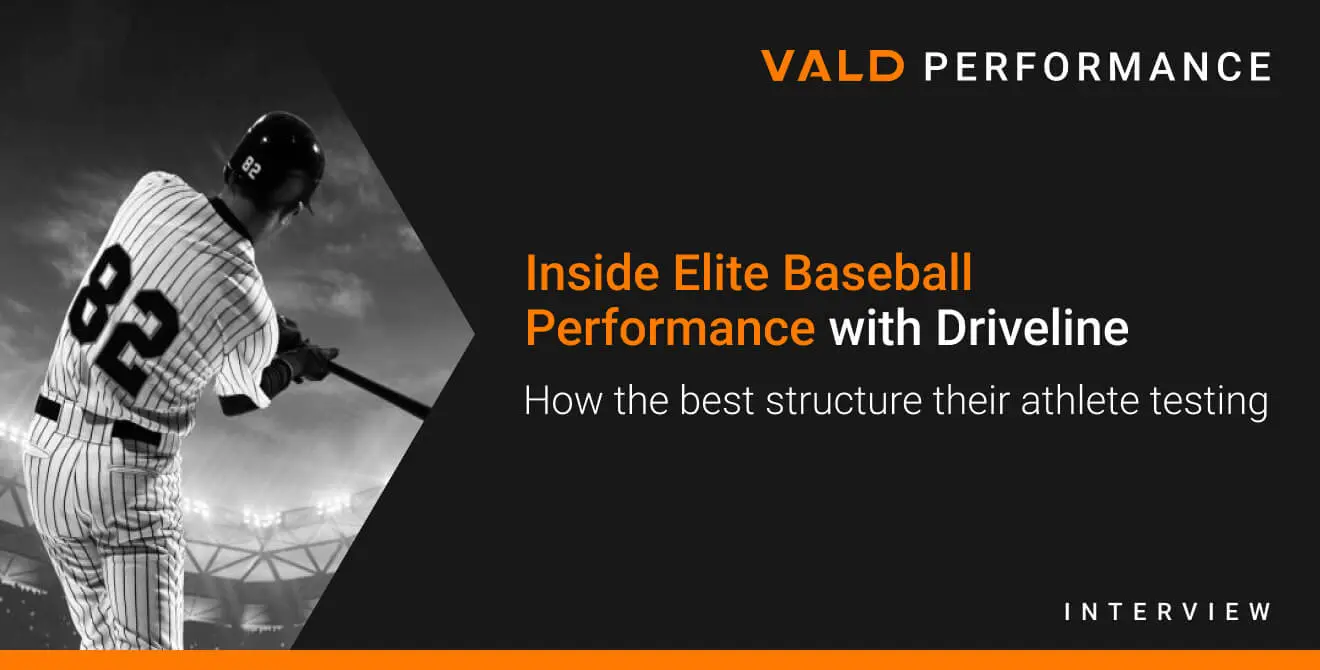
For the last 3 years, Driveline Baseball has incorporated VALD systems such as ForceDecks, DynaMo, and SmartSpeed into their training, profiling and testing process. We wanted to know exactly how these pioneers of baseball performance training implemented our systems to enhance their athlete’s experience. We sat down with Strength & Performance Coaches, Connor White and Zach Settles to learn more.
Background: Driveline Baseball is a private organization in baseball training and analytics, renowned for its focus on advanced assessment and technology to enhance player development. Driveline has gained significant attention in the baseball community for its innovative approaches to baseball pitching and hitting training. They use a myriad of measurement technologies and advanced data analysis to understand and improve the mechanics and performance of elite baseball athletes.
What was the turning point when you decided to elevate your athletic testing process and how did that influence what you’re currently doing now?
Updating our testing process went along with everything we were looking to do as a gym and a business. We came out as a small gym that trains a handful of guys in one-off scenarios and knew that we could provide a better service by adding structure to our training process.
Having force plates allowed us to track large groups of data and gave us the opportunity to build a proven system and scale it into the processes we still have today.
force plates allowed us to track large groups of data and gave us the opportunity to build a proven system and scale it into the processes we still have today.
Now, we’re able to implement our systems based on the data we gathered from the assessment, versus before, when we had trainers responsible for certain guys and left a lot of the progress either un-tracked or measured through more subjective methods.
So, what does that assessment process look like?
We do a total of four tests on ForceDecks; three jump tests and one isometric test:
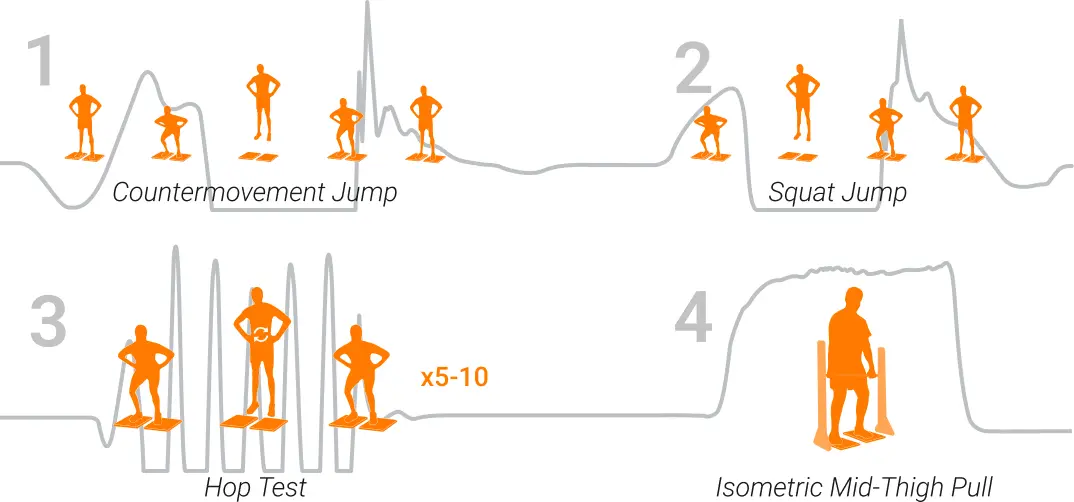
- Countermovement Jump
- Squat Jump
- 10-5 Repeated Hop Test
- Isometric Mid-Thigh Pull (IMTP) (in-depth video here)
That way, we’re getting:
- two measures of explosive strength with the CMJ and Squat Jump,
- we assess reactive strength from the 10-5 Hop Test, and
- get to see their maximal strength from the IMTP.
Force plates enable us to level the playing field with our athletes. We’re taking as much skill out of an assessment as we can and getting as close to the raw physical properties that we’re trying to quantify.
Force plates enable us to level the playing field with our athletes. We’re taking as much skill out of an assessment as we can and getting as close to the raw physical properties that we’re trying to quantify.
Before, we had used a VBT (Velocity Based Training) estimated max back squat for our strength test, and I remember thinking at the time that if I didn’t have back squats in my guys’ training blocks, my assessment wouldn’t be as good.
So, even if I thought front squats or reverse lunges would have been better for their development if I had back squats in my block, they would look better on the tests.
So now, by using ForceDecks with jumps and IMTP, we’re taking as many components as possible out of the testing battery and simplifying to be sure that progress is due to changes in the physical attributes, less than an improved ‘skill’ of the test.
using ForceDecks with jumps and midthigh pulls, we’re taking as many components as possible out of the testing battery … to be sure that progress is due to changes in the physical attributes, less than an improved ‘skill’ of the test.
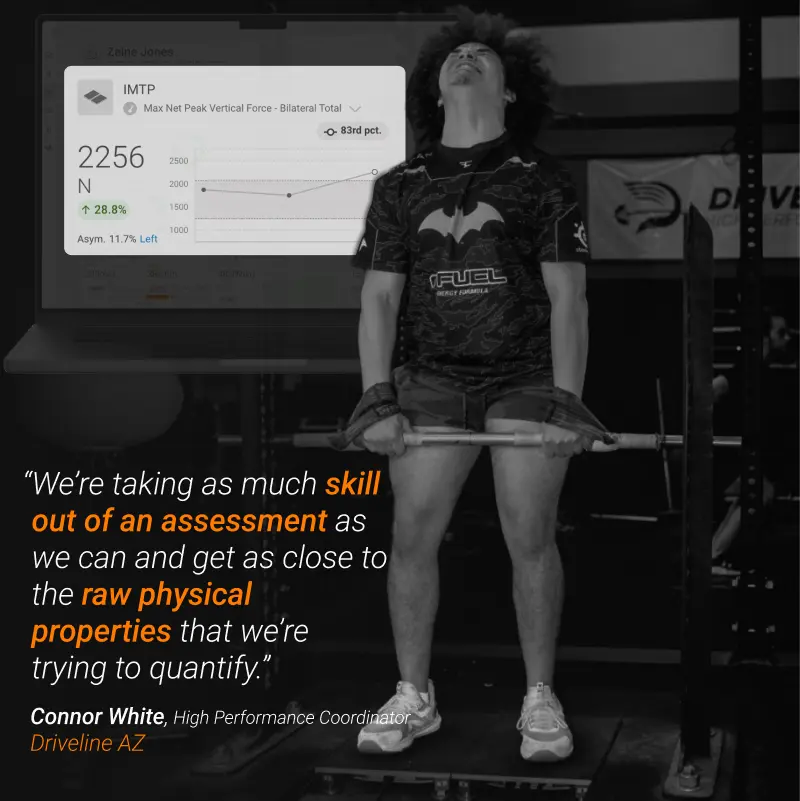
Can you provide an example of how your testing process has changed and what you're able to identify differently now?
The first person that comes to mind would be a player from a couple of years back who was a former Division I tight end, who was getting back into baseball after a couple years of college football.
Immediately, we noticed in his initial assessment that he didn't move well, but his top outputs were high; he was a strong kid.
But, from our own assessment, we could see his issues jump off the page. This guy's been very focused on improving his weight room numbers but hasn’t paid much attention to the little things. His coordination was down, asymmetries were bad, and peak power was a lot lower than you would think based on how he was performing in his strength tests.
So, we focused our training around improving his ability to move through multiple planes, implementing more unilateral work to iron out some of his asymmetries, and exposing him to loads and stimuli that he wasn’t getting from football training.
Within the first 12 weeks, he went from already being well above average in many of our tests, to breaking nearly all of our records and throwing much harder.
Within the first 12 weeks, he went from already being well above average in many of our tests, to breaking nearly all of our records and throwing much harder.
How are you benchmarking your athletes?
That is going to depend on the person we’re working with. If we’ve got a college freshman, All American throwing 90 [miles per hour], it would make more sense to be comparing him to his future goals at the next level. So, in that case, we would compare him to the pro guys we’ve got coming in because that is what his competition will look like soon.
Context is everything.
VALD’s Norms - integrated normative data - provides insights and context on your athletes' performance. Built on millions of secure, de-identified tests from hundreds of thousands of athletes, Norms data provides accurate, robust reference points against which to benchmark your athletes.

The same thing would go for high school seniors; we would be looking at their data compared to college freshmen or sophomores to see who they’re up against in the future.
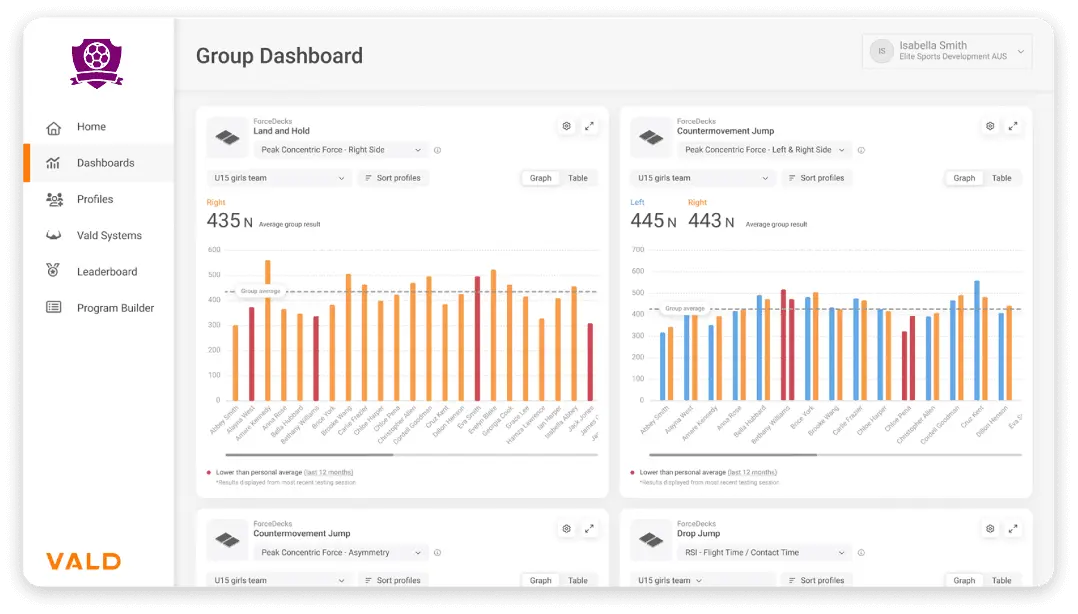
But if we’re working with a high school freshman or sophomore, then we’d compare the age or velocity level that they’re currently at. That way, you can use the two criteria differently to provide better context into where the athlete is at, where the next level is and gives you a nice visualization of the gap between the two.
It’s there where we can see the significant difference between our college and pro guys. Most of the big metrics that we think really matter in their career still show a 20-25% difference between those levels. This leaves a lot of room for growth and improvement.
It’s there where we can see the significant difference between our college and pro guys. Most of the big metrics that we think really matter in their career still show a 20-25% difference between those levels. This leaves a lot of room for growth and improvement for these guys.
What changes when you’re profiling a college or professional player versus a high school or youth athlete?
Our testing battery will stay the same across the board, except for removing the IMTP for the younger ages of our Youth Academy. Partially due to timing and partially because most of our academy players are going to be with us for seven plus years, so an IMTP when they’re 13 won’t change much for us.
While the tests themselves are the same, we know from the hundreds and hundreds of athletes we’ve tested which metrics and attributes are going to be most beneficial for KPIs like bat speed, sprint times and more.
So, it’s mostly the same battery, but the emphasis on trainable qualities will just be a little bit different.
How do you use VALD Hub?
When it seems like the athlete is performing well on paper, I'll go into VALD Hub and scan some of the higher detail metrics like flight time: contraction time, or RSImod to see if there are any nuances we can pick up on their performance. Here, we’re able to find the missing links to squeeze out that extra 1% for a lot of our higher-level guys.
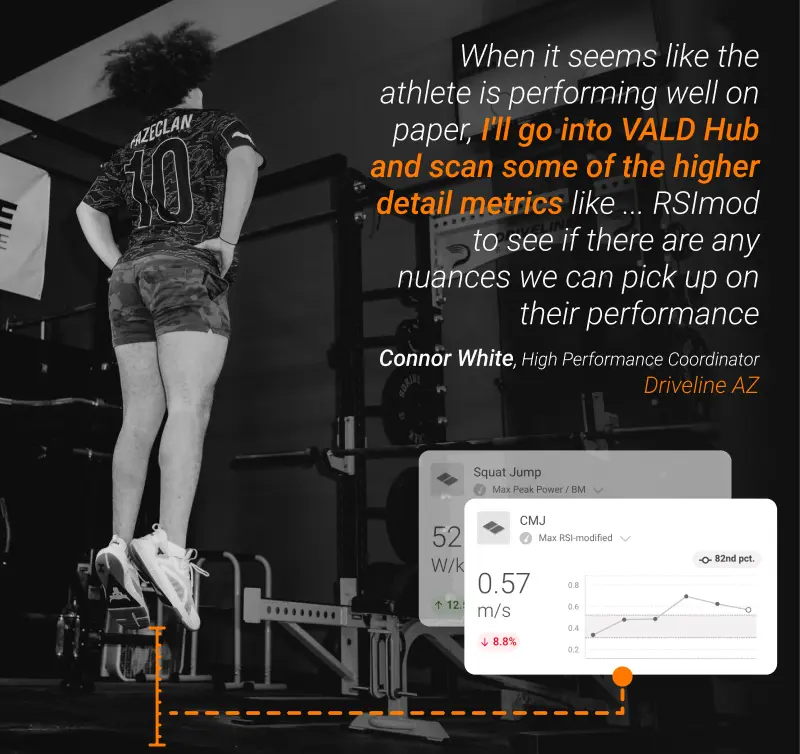
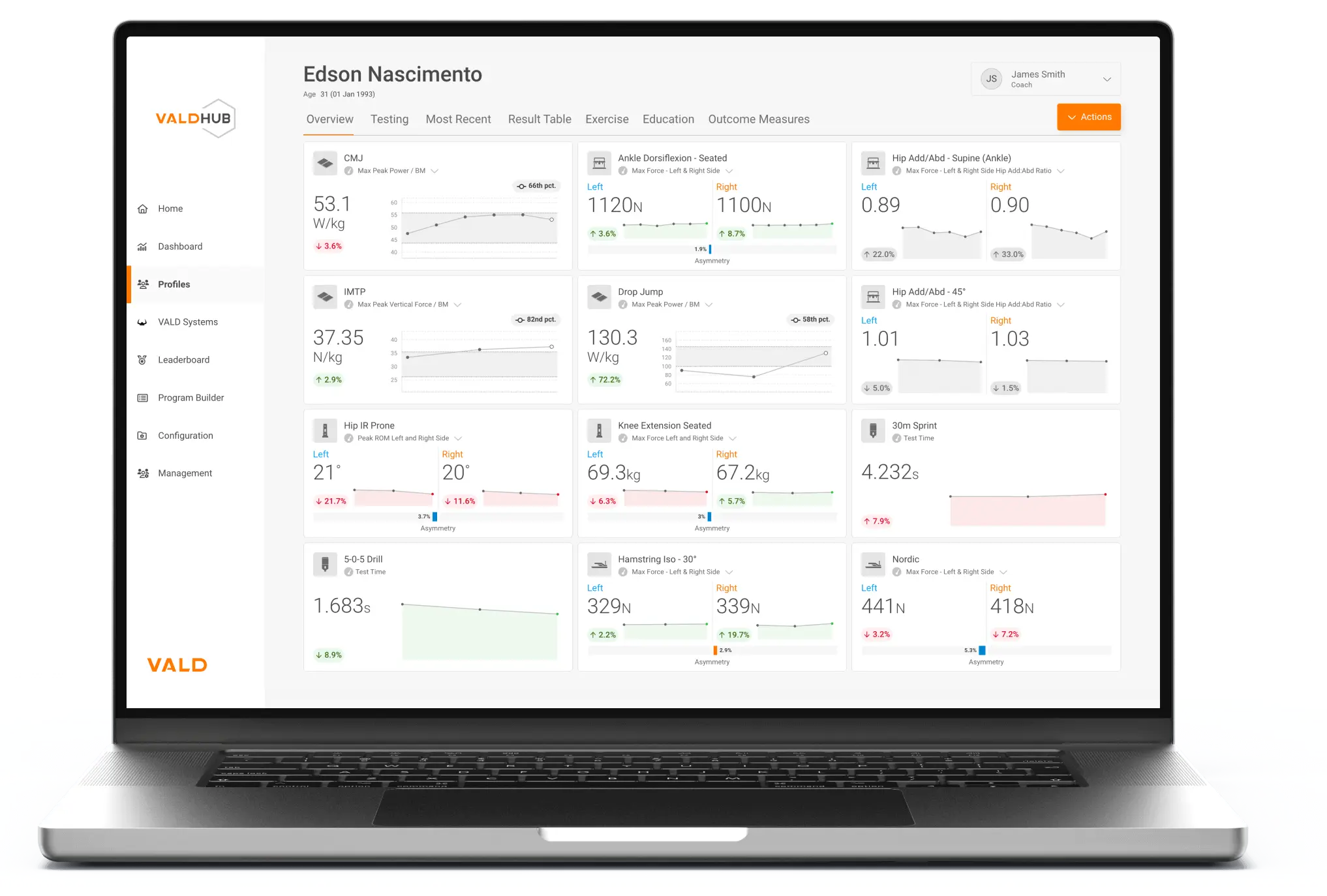
Has your technology had an impact on attracting new athletes to Driveline?
Definitely, the technology is something the athletes get really excited about. I think it’s super helpful for them because you can’t hide from the numbers. Especially with the IMTP, they get very excited about how much more they can pull each time around.
technology is something the athletes get really excited about. I think it’s super helpful for them because you can’t hide from the numbers.
The testing provides us with the ability to paint a picture of what kind of athlete they are, which gives us a guide of how we can build them up over the next 6 weeks. When the numbers improve, you can see the confidence build in these guys and the magic happens when we can show how the numbers in the gym relate to metrics like bat speed or throwing velocity.
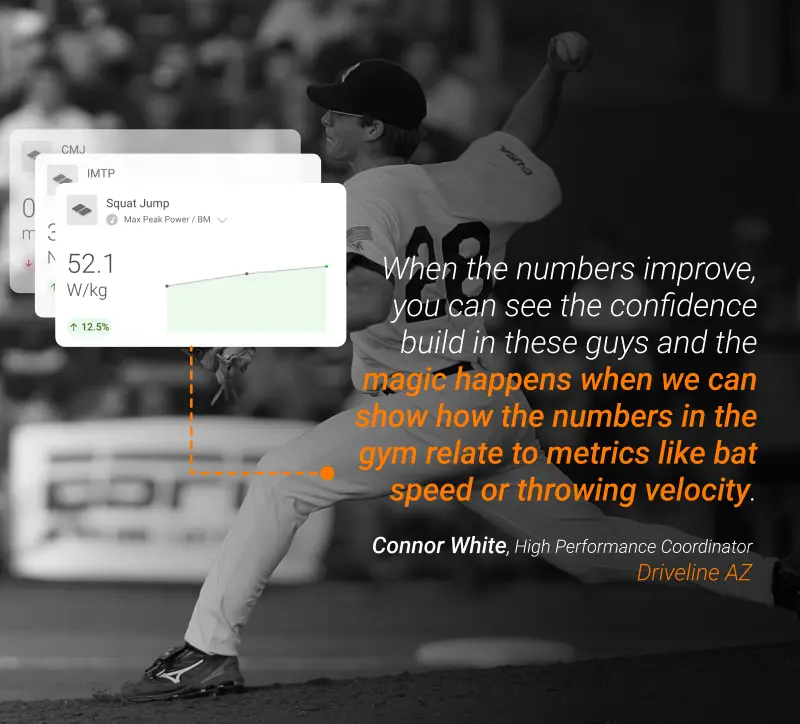
What has been the separator that puts Driveline ahead of the game?
A combination of a few factors. First, I would point to the kind of people who typically work here at Driveline who are usually big on learning, growing and pushing the envelope; we’re constantly searching for what's next.
We’re known for having the plyo balls that provide options for both overload and overspeed (underload) upper body plyos to improve pitch velocity, mechanics, and more. But, given their effectiveness and popularity, they’ve been adopted virtually everywhere. There's practically a facility in every city that will give you overload, and underload throwing training and try to help you throw harder, and gain velocity on your pitch. But the areas that we separate ourselves are in our biomechanics lab, our assessments with ForceDecks, SmartSpeed and DynaMo, the scale of data that we work with, and the people whose hands that data is in. I think that’s the biggest way we separate ourselves.
the areas that we separate ourselves are in our biomechanics lab, our assessments with ForceDecks, SmartSpeed, and DynaMo, the scale of data that we work with, and the people whose hands that data is in.
If you would like to know more about how to integrate VALD’s human measurement technology into your organization to help with the engagement of your clients, please reach out here.
Connon began his journey as a High-Performance Intern for Driveline in 2019 following his tenure as a Sports Performance student-assistant at the University of Portland, where he concluded his college baseball career. Throughout his tenure at Driveline, he participated in several seasons of professional baseball in independent leagues, advancing from intern to High-Performance trainer, then to lead trainer for Driveline AZ, and finally assuming the role of coordinator starting in Fall 2022. In his capacity as High-Performance Coordinator, he enjoys collaborating with the organization's top-tier athletes and ensuring supervision over its strength and conditioning training as well as operational protocols.
Zach currently holds the position of lead High-Performance trainer at Driveline. Previously, he served as a pitching and strength coach at Cabrillo College, following his time as a pitcher at New Mexico Highlands University. His journey with Driveline began as a high-performance intern in March 2021, and he transitioned to a full-time role in September of the same year. He assumed leadership at the new Arizona facility before briefly relocating to California. Eventually, he took on the role of Lead High Performance in Kent, WA.
